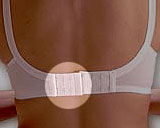So, does it fit?
Contents
A properly fitted bra supports you and/or your breast forms comfortably. You should be able to walk, run and even dance with confidence that everything will stay put. Some movement is natural and even desirable, but wild flailing and bouncing is definitely out.
- When standing relaxed, breasts normally fall halfway between the shoulder and the elbow, with the outside side of the breast slightly inside or outside your body line as viewed from the front. Lengthen or shorten your bra straps as required.
 Your bra should not feel tight or constricting. Most back-closing styles have several hook positions and adjustable straps to help achieve an exact fit. It may be helpful to buy the next larger size. Bra extenders lengthen the back, but may compromise proper fit and proportion at the front.
Your bra should not feel tight or constricting. Most back-closing styles have several hook positions and adjustable straps to help achieve an exact fit. It may be helpful to buy the next larger size. Bra extenders lengthen the back, but may compromise proper fit and proportion at the front.- Breasts should fill your bra cups snugly. Cups that are too small will push your breast forms up and out, occasionally with embarrassing consequences. Cups that are too large let everything flop around uncomfortably (the wild flailing and bouncing we mentioned earlier). Adjusting shoulder straps can sometimes help.
- Your breast forms should stay put. They will be most secure in a full-cup bra (where the cups nearly completely cover the breast), less so in a low-cut or push-up and least in a strapless. Medium- to full-support bras will be most comfortable.
- Your bra shouldn’t ride up or down. The band should be horizontal all the way around. Make sure shoulder straps are properly adjusted. Sometimes a different size or style or advice from a trained fitter can help.
- Shoulder straps that dig into you point to too-narrow straps, poor strap adjustment or the wrong size or style of bra. A bra with wider straps or one with the straps set wider apart can sometimes help. We tend to need much longer shoulder straps than regular women; some bras simply don’t lengthen enough. Look for a different style.


